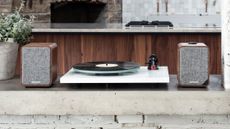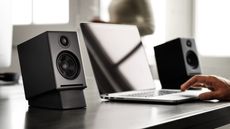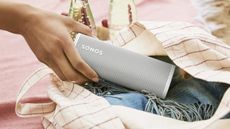Best running headphones 2024: Quick links

01. Best overall: Jabra Elite 8 Active
02. Best sound: Sennheiser Momentum Sport
03. Best fit: Beats Fit Pro
04. Best open-ear: Cleer Arc II Sport
05. Most rugged: Jaybird Vista 2
06. Most comfortable: Shokz OpenFit
07. Best for small ears: LG Tone Free Fit UTF8
08. Best on-ear: Adidas RPT-02 SOL
09. Best for gym use: Beats Powerbeats Pro
10. How to choose
11. How we test
12. FAQ
Looking for the ultimate workout companions? Look no further than our list of the best running headphones.
But hey, let's not limit ourselves – these bad boys aren't just for the track; they're your trusty sidekicks for gym sessions, sports, and any other sweat-inducing activity you throw at them. We're talking about headphones that can handle your most intense workouts without breaking a sweat themselves.
These powerhouses boast features like sweatproof and durable designs, long-lasting battery life, quick charging capabilities, and a snug fit to keep them in place no matter how fast you're pounding the pavement.
Plus, they come loaded with extras like active noise cancelling, customisable sound profiles, and even cases that fight off bacteria. So whether you're hitting the pavement or pumping iron, these headphones will be your loyal soundtrack companions on the road to fitness.
Best running headphones to buy right now
Why you can trust T3
Best overall
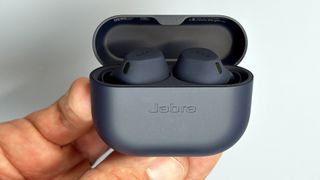
The Jabra Elite 8 Active establishes itself as a premier choice for fitness enthusiasts seeking top-notch workout earbuds. Engineered with durability in mind, these buds feature an IP68 rating and undergo rigorous testing to ensure resilience against sweat, water, and environmental elements.
Sound quality receives a significant boost with Dolby Audio integration, delivering immersive audio with spatial sound capabilities. The buds also employ Adaptive Hybrid ANC and Wind Neutralising HearThrough technology, offering customizable noise cancellation to maintain focus during workouts while remaining aware of surroundings.
In terms of comfort, the Elite 8 Active introduced an updated form factor for enhanced long-term wearability. Although lacking wingtips, the buds provide a secure fit and come with multiple ear gel sizes to accommodate different ear shapes.
The Jabra Elite 8 Active's battery life is commendable, providing up to 8 hours of continuous playback, with an additional 24 hours stored in the charging case.
Overall, the Elite 8 Active represents a significant advancement over its predecessor, offering unmatched durability, superior sound quality, and enhanced comfort for an exceptional workout experience.
Read our full Jabra Elite 8 Active review.
Also consider: The Jabra Elite 7 Active earbuds offer personalised sound, improved fit, and call quality with a three-microphone setup. With eight hours of playback and 22 hours in the case, they offer a similarly impressive battery life, all at a lower cost than the Elite 8 Pro.
Best sound
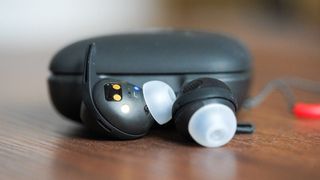
The Sennheiser Momentum Sport combines exceptional sound with fitness tracking capabilities, courtesy of innovative Polar sensors. Despite not replacing running watches for sports tracking, these waterproof buds offer unmatched comfort and functionality. Their user-friendly app enhances workouts, making them a worthwhile investment for fitness enthusiasts.
Integrating heart rate and temperature monitoring into workout headphones is novel, with Sennheiser's offering standing out for its sound quality and user experience. Although similar features exist in competitors like the Amazfit PowerBuds Pro, Sennheiser's brand reputation and refined app make the Momentum Sport compelling.
The touch controls might be fiddly during running, but the 10mm drivers deliver high-fidelity sound, supported by active noise cancellation and transparency mode. Heart rate and temperature tracking, while not perfect, offer added insights for workouts, anticipating broader compatibility with wearables and apps.
Overall, the Momentum Sport excels in comfort, sound quality, and sensor integration, setting a high standard for premium workout earbuds, although future iterations could refine the sensor accuracy and pricing strategy.
Read our full Sennheiser Momentum Sport review.
Best fit
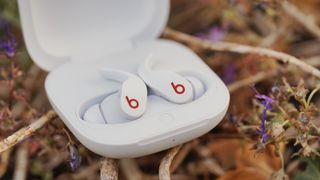

The Beats Fit Pro combines great fit, easy and intuitive pairing and controls, and excellent sound quality. The battery life is about as good as you ask for out of a pair of earbuds such size, and the implementation of the active noise cancellation and transparency mode is phenomenal. Sadly, some of the features are only available to iPhone users, so if you have an Android phone, you might be better off choosing the Jabra Elite 7 Active – those buds also have ANC and transparency mode but lack the wing tips.
As expected from a pair of Beats buds, the Fit Pro has a sublime built quality and design. Unlike the Powerbeats Pro, these gym headphones have a small enough charging case you can quickly sink in your pocket. You'll not be left wanting if you grab a pair of these for your next workout.
Read our full Beats Fit Pro review.
Best open-ear

The Cleer ARC II Sport stands out in the realm of open-ear workout headphones, offering exceptional sound quality and a secure yet comfortable fit. While its price point competes with noise-cancelling earbuds boasting transparency mode, the ARC II Sport's sound clarity and durability make it a compelling choice for audiophiles prioritising workout resilience.
Open-ear headphones like the ARC II Sport are favoured by runners seeking spatial awareness amidst outdoor environments. Cleer's entry into this niche market competes with established players like Shokz, delivering superior audio performance while maintaining situational awareness.
The ARC II Sport features a 35-hour battery life, IPX5 water resistance, and aptX Lossless technology for high-quality audio transmission. Its design emphasizes comfort and stability, with an open-ear configuration supported by flexible earhooks.
Sound quality impresses with 16.2mm neodymium drivers and aptX Adaptive technology, delivering clarity and power across the audio spectrum. Bluetooth 5.3 ensures a stable connection during workouts, enhancing the overall listening experience.
Despite its strengths, the ARC II Sport faces competition from noise-cancelling alternatives at a similar price point. However, its balanced sound signature and spatial awareness benefits appeal to discerning users seeking a premium workout audio solution, particularly those prioritizing lossless music streaming.
Read our full Cleer ARC II Sport review.
Most rugged
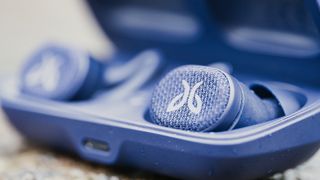

The Jaybird Vista 2 headphones are a real class act. They managed to improve on their predecessor, the excellent Jaybird Vista, by adding ambient sound mode (called SurroundSense) and improved audio performance without losing the buds' signature robust build quality. The Jaybird Vista 2 has an IP68 rating, so it should be able to withstand even the sweatiest of your workouts.
Battery life isn't bad at 6 hours – or 8 hours if you don't have noise-cancelling or SurroundSense on – and the battery case will top that up to a full 24 hours with judicious recharges. The Vista 2 also has a quick charge function; 5 minutes on the charger will replenish 1 hour of playtime. The Jaybird Vista 2 has excellent sound quality, and you can further customise the sound in the Jaybird App. Pro tip: if it feels like the Vista 2 buds aren't loud enough, it could be because the buds' volume is not connected to the Bluetooth volume. Pressing and holding the multifunctional button will increase the volume.
Read our full Jaybird Vista 2 review.
Most comfortable
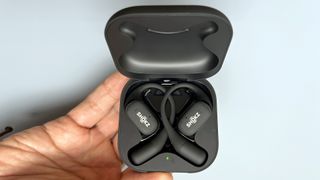
The Shokz OpenFit offers an innovative take on open-ear headphones, providing a comfortable fit and decent sound quality. It features Bluetooth 5.2 connectivity with a 10m wireless range and a battery life of seven hours per charge, extendable to 28 hours with the charging case. With an IP54 water resistance rating, these headphones withstand sweat and light rain.
The design incorporates Shokz's Dolphin Arc Ear Hook, ensuring stability during movement. The lightweight build and soft silicone material enhance comfort, although wearers of glasses may find the ear hooks less accommodating.
Sound quality is delivered through DirectPitch technology and an 18 x 11mm custom dynamic driver unit, offering an engaging listening experience. The open-ear design prioritises situational awareness but may lead to sound leakage in noisy environments.
Despite some limitations in sound isolation, OpenFit's sound signature remains enjoyable, particularly for outdoor activities where environmental awareness is crucial. The Shokz app allows for EQ adjustments and touch control customisation, enhancing the user experience.
Read our full Shokz OpenFit review.
Best for small ears
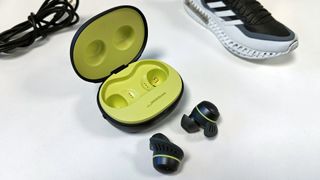
The LG Tone Free fit UTF8 took us by surprise. Not that we didn't expect LG's dedicated workout to sound good, but these compact buds offer so much more than just excellent sound quality. Despite the small form factor – the Tone Free fit UTF8 are some of the smallest workout headphones we've tried – the earbuds sound exceptionally clear. Better still, they have ANC and Ambient Mode, so you can use them for both indoor and outdoor training.
And you will use the LG Tone Free fit UTF8 quite often since they are just so comfortable to wear. There are three wing tips and ear tips included in the box, although we have appreciated a few more as we have slightly larger ears. That aside, there is hardly anything else you could criticise about the earbuds. They are IP67-rated and can be washed under the tap after use. The case also has what's called UVnano technology that shines a blue light on the buds, which is said to kill 99.9% of the bacteria.
Another one of our favourite features is the 'Plug & Wireless' mode, which lets you use the charging case as a Bluetooth transmitter; just connect the case to the treadmill (or whatever) else via a 3.5mm jack to the USB-C cable and listen uninterrupted to the instructions coming from the running machine. Overall, the LG Tone Free fit UTF8 are excellent compact noise cancelling earbuds for running and workouts.
Read our full LG TONE Free fit UTF8 review.
Best on-ear

The Adidas RPT-02 SOL on-ear headphones deliver a premium listening experience tailored for active use, particularly running and workouts. They offer excellent sound quality, long battery life, and effective passive noise cancellation, making them a standout choice for fitness enthusiasts.
Featuring a unique light-harvesting material for charging, the RPT-02 SOL provides up to 80 hours of battery life, making it an ideal companion for extended workout sessions. Despite the lack of active noise cancellation and aptX support, the headphones excel in sound clarity and fit, enhancing the overall listening experience.
The ergonomic design ensures a secure fit during movement, with adjustable cups and washable fabric parts for added durability. However, the tighter-than-usual fit may not be suitable for all-day wear, especially for individuals wearing glasses.
In terms of sound quality, the RPT-02 SOL delivers clear and spacious sound across various genres, with impressive mid-levels and treble. The headphones also offer excellent passive noise cancellation, although some users may find it too isolating for outdoor activities.
Read our full Adidas RPT-02 SOL review.
Best for gym
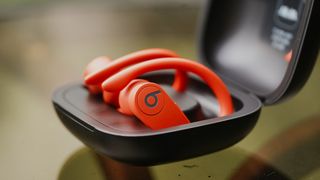

The audio performance of the Beats Powerbeats Pro is beyond amazing – sound comes through the buds with the utmost clarity so that you won't miss a beat – pun intended – even if you are in the middle of the most challenging gym workout session. Thanks to the earhook design, the Powerbeats Pro headphones won't fly off your ears, no matter if you use them for running or kettlebell swings.
The only downside we can think of to Powerbeats Pro is that the battery case is considerably larger than most rivals. However, with 9 hours of life per charge and the ability to give them a charge that lasts a few hours by plugging them in for just a few minutes, the case is a less essential item than it is with other true wireless buds.
Read our full Beats Powerbeats Pro review.
How to choose the best running headphones for you
Performance headphones must sound good and stay in place during the most intense exercise sessions; otherwise, you could just get 'standard' wireless earbuds or wireless headphones. Therefore, before buying your next sports headphones, you must consider the type of exercise you prefer to do and the sound performance you're after.
Runners often choose bone-conduction headphones as they allow them to hear ambient sound, making it safer to run in areas with a lot of traffic. That said, many premium running headphones have a 'hear-through' feature, allowing the buds to let sound in.
Cyclists are in a tricky situation; they can't use bone-conduction headphones as there is too much wind noise, so they must use in-ear headphones when they ride. They are also limited in terms of design. For example, ear hook models would be ideal for cyclists to ensure they won't lose them – you really don't want headphones falling out of your ears when you're zooming down a slope at 40 mph – but since they often wear cycling sunglasses, the ears are already taken, so to say. Cyclists should use in-ear buds with excellent grip and adjustable eargels and wingtips.
Gym bunnies and buffs often use over-ear headphones to cancel out ambient noise and help them stay in the zone without having to fiddle around with how the buds fit. They don't have to worry about cars coming their way when they lift; their main concern is maintaining the mind-muscle connection.
How we test the best running headphones
Our running headphones testing process involves listening to music, podcasts and audiobooks during sweat-inducing workouts to see how well they can distract our attention from the pain caused by working out too much. As well as putting the sports headphones through their sound quality paces, we also pay particular attention to fit and how well they cope with intense head movements during HIIT workouts and sprints.
It's simply the worst when buds fall out of your ears during a run or lifting workout; as such, headphones that don't fit well can't be included in this guide. Finally, we test running earbuds' durability and sweat resistance and whether they live up to the claims manufacturers made in their promo materials. And yes, sometimes this involves taking a shower while wearing swim-proof headphones. Grow up, people.
Read about how we test at T3 by clicking on the link.
FAQ
Which type of headphones is best for sports?
Many runners prefer bone-conduction headphones for running as those leave the ears uncovered and the person more aware of their surroundings. For the same reason, these headphones might not be the most ideal in noisy environments since they let in too much ambient noise, making it hard to hear what's being played in the headphones.
Running headphones with ambient mode are a good alternative as these buds often also have active noise cancelling (ANC). When the ambient mode is turned on, the earbuds use their microphones to feedback sound from the outside world so that you're more aware. When running indoors – e.g. on a treadmill – you can activate ANC and block out sound, so you can get in the zone easier.
What are the best waterproof headphones for running?
Technically speaking, the best waterproof headphones for running is the Jaybird Vista 2, as it's IP68 rated. In fact, unless they change the ingress protection rating system, no future buds can be more resistant to solids and liquids than the Vista 2s.
That said, just because some headphones aren't IP68-rated doesn't mean they are suitable for sweaty workouts. For example, the Jabra Elite 7 Active have an IP57 rating, so unless you need headphones for swimming, they should be more than okay.
Bone conduction headphones often have an excellent ingress protection rating as they haven't got speakers – instead, they vibrate your cheekbones to produce sound. The Shokz OpenRun have an IP67 rating, so you can rinse them under the tap after workouts without any issues.
For comparison, the Beats Fit Pro are IPX4-rated, and even those headphones are said to be sweat and water-resistant. To summarise, unless you want to keep your running headphones underwater for prolonged periods of time, any headphones with at least an IPX4 rating should suffice.
In-depth: What are the best waterproof headphones for running?
Are over-ear headphones better for running?
Many runners use over-ear headphones as they provide a more robust sound and often a more secure fit than in-ear buds. It's true – it's less likely that over-ear headphones will fall out of your ear unnoticed. However, they will make your ears warmer (not ideal for long runs) and block out ambient noise, which also isn't ideal when you run in traffic. So, as they say, you win some, you lose some when you wear over-ear headphones for running.
Is it better to run with earbuds or headphones?
Modern earbuds produce a fuller sound and provide a secure fit, making them better suited for running and workouts. Considering the small form factor, these listening devices can be worn longer than headphones, improving comfort levels. On the other hand, headphones produce a more robust sound, thanks to their larger drivers. Some people also prefer them for their noise-isolation properties; it's easier to stay in the zone when your ears are covered with huge cans.
Do noise cancelling headphones work in the gym?
Gyms are noisy environments. Loud music blares from the speakers, weights and machines clank, and people talk and groan, which can be quite a lot to cope with both for people and headphones. Are the best gym headphones able to cope with such noise levels? Yes and no.
There are different types of noise cancellation technologies and features, including noise isolation and active noise cancellation (ANC), to name a couple. Over-ear headphones often provide at least noise isolation, as they cover your ears, naturally filtering out some of the ambient noise.
While smaller earbuds also offer some noise isolation – they sit in the ear canal, after all – they are better at providing ANC, which uses noise-cancelling speakers to reduce unwanted background noise. Premium headphones brand Bang and Olufsen uses microphones that "listen" to the sounds outside and inside of the earphones. Based on this, the ANC chipset inverts the soundwaves, and a speaker inside the earphone cancels the outside sound by neutralising the soundwaves.
This can be quite effective; some headphones can cancel out up to 42dB of noise. This is enough to make the outside world quieter, albeit not completely silent. Even if there were headphones that could completely silence all outside noise, we wouldn't recommend these in gyms, as you do have to pay attention to your surroundings in case of an emergency. Some noise isolation r cancellation is fine, though.
Is it a good idea to run with headphones in?
Running with headphones can enhance the running experience for many people by providing motivation, distraction, and entertainment during workouts.
However, it's essential to use caution and be aware of your surroundings while running with headphones, especially outdoors. Listening to music at high volumes can potentially reduce your awareness of traffic, cyclists, pedestrians, and other hazards, increasing the risk of accidents.
Additionally, wearing headphones can block out important sounds like approaching vehicles or warnings from fellow runners. Therefore, while running with headphones can be enjoyable and beneficial, it's crucial to prioritise safety and use them responsibly, considering the environment and potential risks.







